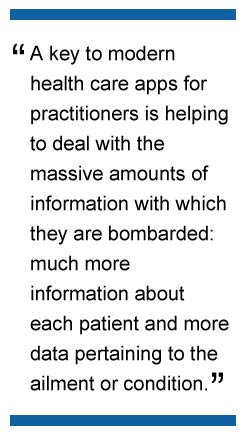Digitization and mobility are revolutionizing the practice of medicine. The changes have been ongoing for a decade and won’t stop until the last doctor puts down the last stethoscope.
At this point, the mobile health care app world is still a bit of a wild west: many great ideas for improving health care, many great apps and not too much structure. Practitioners and the IT departments charged with fulfilling their communications needs must find a systematic way to wade through the array of applications and tools available.
It’s not easy. Practitioners and IT departments must work together to find the applications that go beyond glitz to actually solve a problem or fill a need. They must also do so in a manner that meets the requirements of The Health Insurance Portability and Accountability Act (HIPAA) and other federal, state, local and facility-specific security requirements.
Address Real Health Care Provider Needs
The first step is identifying the issue that the application is aimed at addressing. This sounds like a no-brainer, but it can be deceptive. Terry Edwards, the CEO of PerfectServe, which provides an app that improves communications and collaboration between health care team members, describes meeting with a hospital’s chief medical officer. The executive said that he needed a product to solve a particular problem and assumed an app or new platform was the answer.
Not so.
“It turned out that the problem that needed to be fixed was in the underlying communications infrastructure in the organization,” Edwards said. “A process was broken. Once he fixed that, he was okay.”
The real goal is to use mobility to go beyond merely replacing paper or earlier electronic approaches. Greg Samuels, the CIO of Commonwealth Anesthesia, an anesthesia practice in Richmond, Virginia, uses the operating room (OR) as an example. Samuels says that the traditional approach is to use a workstation in each OR. Now, he says, a supervisor with a laptop and appropriate software roams the ORs and monitors drugs being administered, patients’ vital signs and other key parameters.

The Commonwealth team suggests that the process by which a medical facility chooses an app and an app provider should feature a good helping of traditional due diligence: Research the options, meet and/or teleconference with potential providers, check references, and assess whether the company is likely to be around for the long term. The app should be seen in action, if possible.
The key is to not let the tail wag the dog. “We go through a process with the providers designed to identify what was important to them and match the application to that,” said Bruce Donald, Commonwealth’s Chief Operating Officer. “Rather than trying to find the app we thought was needed, it was the reverse.”
Dealing with the Data
A key to modern health care apps for practitioners is helping to deal with the massive amounts of information with which they are bombarded. This avalanche comes in two ways: Much more information about each patient is available and more data is available pertaining to their ailment or condition. For this reason, experts say that an almost unavoidable development is a marriage between mobile apps and Big Data. The former brings speed and agility and the latter brings unprecedented real-time research capabilities offered by platforms such as IBM Watson.
Other keys are proactivity, ease of use and context. Dr. Erin Jospe, a practicing physician and Associate Chief Medical Officer at PatientKeeper, which produces an app that provides instant, provider-determined access to patient information on mobile devices, says that it is important to find applications that easily interact with other applications and tools. Apps must be intuitive, give the user the ability to easily sift through data, and must empower the practitioner to use the information that is generated. “The hallmark is that you must be able to move beyond view-only and act on things,” Dr. Jospe said.
Jospe also suggests that individual apps will need to be able to work with others. Experts suggest that now discrete apps will become modules on platforms, perhaps running on iOS and Android, that will share underlying infrastructure, such as Big Data capabilities, common user interfaces and other features.
The future of apps designed for health care practitioners and providers is bright – and still confusing. That makes sense, since the evolution of mobile applications for health care still is near the starting gate. “The next step in the process is a layer on top of all the data we are creating,” said Nikhil Krishnan, a research analyst at CV Insights. “The next layer of tools will allow doctors to see what’s important and what’s not in these gigantic data sets.”
Carl Weinschenk covers telecom for IT Business Edge. He writes about wireless technology, disaster recovery/business continuity, cellular services, the Internet of Things, machine-to-machine communications and other emerging technologies and platforms. He also covers net neutrality and related regulatory issues. Weinschenk has written about the phone companies, cable operators and related companies for decades and is senior editor of Broadband Technology Report. He can be reached at [email protected] and via twitter at @DailyMusicBrk.


